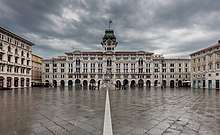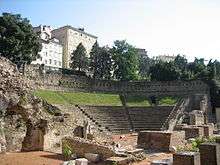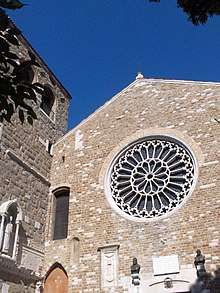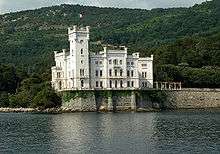Trieste
Trieste (Triest in German, Trst in Slovenian and Croatian) is a city in North-East Italy that was once a very influential and powerful centre of politics, literature, music, art and culture under Austrian-Hungarian dominion.


Today, Trieste is often forgotten as tourists head off to the big Italian cities like Rome and Milan and it is a very charming and underestimated city, with a quiet and lovely almost Eastern European atmosphere, several pubs and cafes, some stunning architecture and a beautiful sea view. It was also, for a while, the residence of the famous Irish writer, James Joyce.
Understand
Trieste is the capital of the autonomous region of Friuli Venezia Giulia and has over 204,000 inhabitants (2018). It is at the crossroads of several commercial and cultural flows: German middle Europe to the north, Slavic masses and the Balkans to the east, Italy and then Latin countries to the west and the Mediterranean Sea to the south.
Its artistic and cultural heritage is linked to its singular "border town" location. You can find some old Roman architecture (a small theatre near the sea, a nice arch into old city and an interesting Roman museum), Austrian empire architecture across the city centre (similar to stuff you can find in Vienna) and a nice atmosphere of metissage of Mediterranean styles, as Trieste was a very important port during the 18th century.
Talk
The region of Friuli Venezia Giulia is officially quadrilingual (Italian, Slovene, Friulian, and German). Signs are often only in Italian in Trieste, as the city is generally Italian speaking and the local dialect (a form of the Venetian language) is called Triestine. Surrounding villages and towns are often inhabited by mostly Slovene speakers. Residents, and those working in the city, can easily find free courses to learn Italian, Slovene, German, English and many other languages. When walking around Trieste, you will also hear Croatian/Serbian all the time, mainly from people who visit the city on brief shopping trips.
Get in
By plane
🌍 Trieste – Friuli Venezia Giulia Airport (TRS IATA) (33 km (21 mi) north of the city centre).
The airport is just off the A4 Trieste-Venice motorway (Redipuglia exit). Long and short-stay car parks are available. Transport options include:
- Bus number 51, run by APT, runs to the airport from Trieste's bus station (next to the railway station). Weekdays buses leave at 5 minutes and 35 minutes past the hour. On Sundays the service is every 1 to 2 hours. The bus takes about 55 minutes. Tickets can be purchased at city bus/coach stations or at the airport: in the Arrivals Hall, with an automatic machine for self-ticketing and at the Post Office.
- ''Trieste Airport'' Railway Station is in front of the airport. The station is on the Trieste-Venice railway line, 25 minutes ride from Trieste.
- Taxis are available outside the Arrivals hall from 08:00 to 00:00. Taxi fare to Trieste is around €70 and takes 30-35 minutes.
Other nearby airports (less than 2 hours from Trieste by private or public transport) include Venice Marco Polo, Venice Treviso, Ljubljana (Slovenia) and Pula (Croatia).
By bus
Local routes include Udine, Grado, San Candido/Innichen
At the 🌍 Trieste coach station, bus and coach connections to several European countries, including Slovenia (Izola - Isola, Koper - Capodistria, Ljubljana, Piran - Pirano, Portorož - Portorose, Postojna - Postumia, Sežana - Sesana), Croatia (Dubrovnik, Poreč - Parenzo, Pula - Pola, Opatija - Abbazia, Rijeka - Fiume, Rovinj - Rovigno, Split - Spalato, Zadar - Zara) and Serbia (Belgrade - Belgrado) are available. Connections to Germany and Austria are available via Flixbus.
By car
A4 Venice-Trieste, toll-gate Monfalcone-Lisert, exit point "Sistiana" (SS 14 "Costiera" ). The town is 24 km from the motorway.
SS 202 Triestina: Motorway A4, toll-gate Lisert, Carso Plateau, Opicina, Padriciano, Trieste
SS 15 Via Flavia: Koper (Slovenia) - Rabuiese border
SS 58, Carniola highway: Ljubljana (Slovenia) - Fernetti border - Opicina, where the highway joins to SS 202, Trieste
By train
🌍 Trieste Centrale railway station. There's a left luggage office open from 8-18h. One piece is €5.
Lots of trains from Venice and Udine, InterCity trains from Rome and Florence, FrecciaBianca from Milan and Torino at the Central Railway Station. If you arrive by train, the last 15 minutes of travel you have a beautiful sight, because the railway goes along the sea and if the weather is good it should be very striking.
Trains from Central Europe have all but diminished, the easiest option is to travel to the Slovenian border town of Sežana, which sees six daily trains from Ljubljana. From there, take a taxi across the border to Villa Opicina (5 km/10 minutes/€10 - Taxi Tirič +386 41 62 13 47, Taxi Kras +386 40 23 34 90). To reach Trieste it's possible to travel by bus No. 2 or 4. The scenic historic tram to the city centre is out of service (see Get around).
There is bus service between Sežana and Trieste: buses go only in the early morning and early afternoon.
Get around
On foot
Like most of Europe, a stroll through the town to admire its ancient architecture is a very popular activity. You get to travel at your own pace and even get some coffee along the way. Trieste is not particularly big and if you do not have luggage with you there is no need to take a bus.
By public transport
Trieste has a network of buses running on a strict schedule. This can often be checked on the web. Routes are very frequent through the day but rarer after 21:00 in the evening, on Sundays and holidays. Strikes occasionally affect buses but Trieste is a small city and most places of interest can easily be reached on foot.
Tickets cost €1.25 each, and can be bought from tobacconists and from machines which are found at some of the busier bus stops. Tickets are valid for 60 minutes and allow unlimited change of routes within that time. Once onboard, the tickets must be validated using the machines which stamp the time of first use.
- 🌍 Trieste–Opicina tramway. The bus system includes the #2 tram to Opicina, which is regarded as an attraction itself. Since 2016 the tram has been out of service due to an accident. Restoration work to allow an eventual reopening is underway, possibly in 2020.
For a small extra fee (€2-4) you can get unlimited bus and tram service with your FVG Card, which can be purchased at the Trieste tourist office in Piazza Unita d'Italia.
See

Unlike many other Italian cities, Trieste's all-inclusive tourist pass is well worth the price. The FVG Card can be purchased at the tourist center in Piazza Unita, and includes free access to nearly all the major attractions in the Trieste area, and many in other nearby cities. €18 for 48 hours, €21 for 72 hours, and €29 for 7 days.
Sights


- 🌍 Città Vecchia (Old Town). Trieste boasts an extensive old town: there are many very narrow and crooked streets with typical medieval houses. Nearly the entire area is closed to traffic.
- 🌍 The Austrian Quarter. Half of the city was built under Austrian-Hungarian dominion, so there are a lot of palaces that resemble Vienna. An iconic place of this quarter is the majestic Piazza Unità (Unity Square), which is Europe's largest sea-front square. The most present architecture styles are Neoclassical, Art Nouveau, Eclectic, and Baroque.

- 🌍 San Giusto - Cathedral and Castle. A walk on the castle ramparts and bastions gives a complete panorama of the city of Trieste, its hills and the sea.
- Museum
- Capitoline Temple
- Church of San Giovanni
- San Michele al Carnale
- WWI Altar
- Roman forum and civic building
- Castle of San Giusto
- Park of Remembrance World War I commemorative park,
- Lapidary Garden. Contains Roman and Medieval relics discovered in Trieste. In it stands a Cenotaph to the archaeologist Johann Winckelmann, father of neoclassicism, who died in Trieste in 1769.

- 🌍 Miramare Castle. This historic 19th-century castle is a 20-minute trip from Piazza Oberdan on the #6 bus.
- Maximilian's Chambers and those of his consort, Carlota of Belgium; the guest rooms; the information room telling the history of the Castle and the Park's construction.
- Duke Amadeo of Aosta's apartment with furnishings from the 1930s in the Rationalist style.
- Throne Room
- The park offers the public a chance for an interesting stroll among botanical species and an important collection of sculptures dotted along its numerous paths.
- The Stables, a building which was restored and is now used for temporary exhibitions;
- The Old Greenhouses
- Little Castle containing the seat of the Direction of the Natural Marine Reserve of Miramare and a small number of aquariums
- 🌍 The Roman Theatre. Trieste or Tergeste, which probably dates back to the prehistoric period, was enclosed by walls built in 33-32 BC on Emperor Octavius’s orders. The city developed greatly during the 1st and 2nd century AD. The Roman Theatre lies at the foot of the San Giusto hill, and faces the sea. The construction partially exploits the gentle slope of the hill, and most of the construction work is in stone. The topmost portion of the amphitheatre steps and the stage were presumably made of wood. The statues that adorned the theatre (which was brought to light in the 1930s) are now preserved at the Town Museum. Three inscriptions from the Trajan period mention a certain Q. Petronius Modestus, a person who was closely connected with the development of the theatre, which was erected during the second half of the 1st century.
- 🌍 Il Faro della Vittoria (Victory Lighthouse). The Lighthouse of the Victory, an impressive work of the Triestine architect Arduino Berlam (1880-1946) and of the sculptor Giovanni Mayer (1863-1943), has two important functions. Besides lighting the gulf of Trieste, in order to help navigation, it also serves as a commemorative monument dedicated to the fallen of the First World War. The lighthouse is topped by an embossed copper statue of Victory sculpted by Giovanni Mayer. Under this statue is affixed the anchor of the torpedo-boat Audace (the first Italian ship that entered the port of Trieste on November 3,1918).
- 🌍 Arco di Riccardo. An Augustan gate built in the Roman walls in 33 AD. It stands in Piazzetta Barbacan, in the narrow streets of the old town.
- 🌍 Canal Grande. Trieste's beautiful grand canal, just up the street from Piazza Unità. Step onto the bridge to pose with a bronze statue of James Joyce, one of Trieste's many iconic statues that walk the streets instead of standing on pedestals.
Museums
- 🌍 Museo Revoltella, Via Diaz 27. This museum was donated to the city in 1869 by Baron Pasquale Revoltella, a great patron of the arts who liked to surround himself with precious and avant-garde works. In a building restored and extended by architect Carlo Scarpa, the museum today houses one of Italy’s finest collections of 19th-century, modern and contemporary art.
- 🌍 Museo di Storia, Arte e Orto Lapidario (Museum of History and Art and Lapidary Garden), Piazza della Cattedrale, 1 Trieste. Tu-Su 09:00-18:00. Archaeological, historical and art collections. Prehistoric and protohuman findings of local origin; Roman and medieval sculptures and epigraphs. Egyptian, Greek, Roman and pre-Roman antiques. Numismatic collection. Photograph and book libraries. €5, €3 reduced.
- 🌍 Museo di Storia Naturale. Zoological, botanical, geological, palaeontological and mineralogical collections. Vivarium. Specialised scientific library.
- 🌍 Museo della Comunità Ebraica di Trieste "Carlo e Vera Wagner" ("Carlo e Vera Wagner" Museum of the Jewish Community of Trieste). Collection of ritual art of the Jewish community of Trieste, mainly silverware and fabrics.
- 🌍 Museo della Risiera di San Sabba (Risiera di San Sabba Museum). A national monument - a testimonial of the only Nazi extermination camp in Italy.
- 🌍 Railway Museum Trieste Campo Marzio. Closed since July 18, 2017 for restoration.. Housed in the former railhouse, the museum features drawings, models and fullsized train engines and railcars as well as horse-drawn trams from Trieste's past.
- 🌍 Museo Sartorio, Largo Papa Giovanni XXIII, 1, ☎ +39 040 301479. Tu-Su 10:00-18:00. Art collections donated to the city by the Sartorio family. Paintings from the 19th and 20th centuries; sculptures; sketches by Giambattista Tiepolo. Full: €6; reduced: €4.
Natural wonders

- 🌍 Grotta Gigante (15 km by city bus #42. Two wide parking lots are available on the outside.). This giant cave claims to be the biggest tourist cave in the world (since 1997 in the Guinness Book of Records). The enormous hall is 107 m high, 280 m long and 65 m wide. The multi-lingual guided tour takes about 45 minutes. You can also visit the Museum of Speleology is near the cave and besides the various speleological, geological and paleontological finds it also includes some valuable archeological pieces and a poster collection of the cave.
Places of worship
- 🌍 Saint Spyridon Church (Serbian Orthodox Church of St. Spyridon), 9, Via San Spiridione. Tu-Sa 09:00-12:00, 17:00-20:00; F 09:00-12:00.
- 🌍 Synagogue of Trieste, ☎ +39 040 6726736. Su 10:00-12:00; Th 15:30-17:30. It's one of the largest in Europe, and was built in 1912. Guided tours only.
Do

_Il_Lungomare_005.jpg)
- 🌍 Molo Audace. The long pier across from Piazza Unica d'Italia. An amazing place to relax and watch the sunset.
- The Karst (Kras in Slovene, Carso in Italian). The limestone plateau above the city on both sides of the border. It is ideal for walking and offers excellent views of the Gulf of Trieste, coastal areas of Slovenia, and northern Croatia. Many of the villages in the Karst are majority-Slovene speaking areas. The principal town in the Karst is Opicina.
- 🌍 Strada Vicentina (Tram #2 to Obelisco station, or take a bus). A pedestrian road stretching from Opicina to Prosecco, about 6km long. The views are superb.
- Barcola. Trieste's concrete, sandless beach just south of Miramare. You can sunbathe here.
- Sailing with Discover Friuli, ☎ +39 339 7245055, e-mail: info@discoverfriuli.com. This tour agency offers half-day and full-day sailboat cruises around the Gulf of Trieste, with great views of Duino, Miramare, and the surrounding landscape from the sea. €100-234 depending on length/group size.
Buy
During the 1970s and 1980s Trieste was the number one shopping destination for tourists from Yugoslavia.
- Ghetto and Piazza Unità. for Biedermeier and Liberty furniture, Bohemian glassware and Austrian silverware, and other fine antiques.
- Glassworks from France and Venice.
- Paintings
- Prints and antique engravings as well as books, postcards, and historical photographs.
Eat
The cuisine of Trieste reflects the living traditions of the many populations that have passed through the city over the centuries. In the city's restaurants, called "buffets", you can find delicious examples of the local Austrian and Slavic tradition.
- Caldaia Traditional dish of boiled pork.
- Jota a soup prepared with pork, potatoes, cabbage, and finely-ground beans
- Gnocchi in the style of Austrian dumplings, made with everything from ham to stuffed with plums.
- Brodetto Fish soup
- Risotto Creamy rice dish
- Sardoni in savor flavored pilchards
- Salads common favorites here include chicory and rocket
- Bruscandoli
- Farmers of the plateau who had been allowed by an imperial decree to sell their own products during a period of 8 days, organized the so-called osmizze, where it is possible to taste local wines and products, such as Monrupino's tabor cheese and honey from San Dorligo.
- The pastry shops in Trieste offer delicious local varieties of the most famous Austrian cakes: Sacher torte, krapfen, strucolo cotto and strucolo de pomi (local varieties of strudel), chiffeletti (cookies made with flour, eggs and potatoes and fried in oil)
- During Easter you can taste the pinza, a sweet leavened bread that many women still prepare at home and take to the bakery to be cooked. Richer variants of this are the titola, decorated with a hard-boiled egg, putizza and presnitz. Fritole, pancakes stuffed and fried in oil and fave, small round cookies made with almonds and aromas are typical during Carnival.
Restaurants
- Al Barattolo, Piazza S. Antonio Nuovo 2. Considering that this restaurant is right at the Grand Canale, it has very moderate prices (and of course a beautiful view).
- In the first little alley to the left of the Piazza Unità d'Italia, leading towards the hill, there are several small pasta restaurants and bistros.
- Antica Trattoria Le Barettine (Le Barettine), Via del Bastione, 3, ☎ +39 040 3229528, +39 348 4780518 (Mobile), e-mail: debaseggiofabri@libero.it. M Tu 19:30-23:00; Th-Su 12:30-15:00, 19:30-23:00. Italian seafood restaurant, huge wine collection, in Trieste's historical city center. €30-50.
- Buffet da Siora Rosa, Piazza Hortis 3, ☎ +39 040 301460. Tu-Sa 08:00-21:30. One of Trieste's oldest family-owned restaurants operating since before World War II, serving typical Triestine cuisine. Particularly famous for their proscuitto cotto: cooked ham served with piquant mustard and horseradish. €10-25 per person.
Drink
Some local specialties include:
- Frambua - from framboise - mint and tamarind
- Grappa
- Terrano wine other popular local wines include the Rosso, Malvasia, and the white Vitovska Garganja.
Coffee
Coffee has been an important part of Trieste since the 1700s. Some of the most famous caffè, known as much for their famous patrons as their food and drink, include:
- Caffè Tommaseo, Riva 3 Novembre.
- Caffè San Marco, via Battisti, 18. Open since 1914, San Marco is as popular with today's students and tourists as it was in the days of Saba and Giotti.
- Caffè Torinese, Corso Italia, 2. Perfectly preserved gem from the 19th century.
- Caffè Pasticceria Pirona. One of the few remaining petesserias (cake shop that also sells coffee and liqueur, as well as beverages made from) to have retained its Viennese charm. One of its most devoted customers was none other than James Joyce.
- Caffè degli Specchi, Piazza Unità d'Italia.
- Chocolat, via Cavana 15. It's a must for hot chocolate in wintertime and chocolate icecream in summertime.
Locals usually enjoy coffee at the bar in the form of a capo in B, a small cappuccino (kind of like a macchiato but with a but more milk and foam) served in a glass cup. This is a unique kind of coffee only served in Trieste.
Sleep
.jpg)
The helpful tourist information in Piazza Unita can provide you with a list of accommodation and will even make bookings for you. They also have free maps.
Budget
- 🌍 The Tergeste Youth Hostel, Viale Miramare, 331 (Take line 36 from Oberdan Square to Grignano. Journey takes between 10 and 20 minutes depending on traffic and passes the railway tracks and beach of Barcola. Get off at the Miramare junction, two minutes walk to the hostel.), ☎ +39 40 224102, e-mail: ostellotrieste@hotmail.com. 74 beds, restaurant indoors and a snack-bar and restaurant on the panoramic terrace. The youth hostel is easily reached by bus. It has a fantastic location with the Adriatic Sea just a few metres in front of it.
- 🌍 B&B Adria, Sistiana, 59/V, ☎ +39 328 09 77 182, e-mail: adriasistiana@libero.it. Close to the Castle Duino, the Rilke Promenade above the Natural reserve of Duino's Cliffs, very good connections with public transport to airport and downtown. Staff is very friendly and helpful. Double rooms min/max €22/24 per person/night, breakfast is included.
Mid-range
- 🌍 Hotel Porta Cavana, Via Felice Venezian, 14, ☎ +39 4030 1313, e-mail: hotelportacavana@libero.it. Close to the beautiful Piazza Unità, its rooms have a CD-player, and cable TV. Staff is friendly and speaks English. Singles/doubles min/max €36 - 130.
- 🌍 Hotel Roma, Via Ghega 7, ☎ +39 040 370040, e-mail: info@hotelroma-trieste.it. 3-star hotel in the centre. 19th-century building, hotel bar and even business facilities.
- 🌍 NH Jolly Trieste, Corso Cavour 7, ☎ +39 040 7600055.
- Hotel Al Ponte, viale Trieste 124, Gradisca, ☎ +39 0481 961116.
Splurge
- 🌍 Greif Maria Theresia, Viale Miramare 109, ☎ +39 040 410115. Elegant hotel few minutes by car from the centre, with indoor swimming pool. €120-250.
Stay safe
Trieste has a reputation of being one of Italy's safest cities possibly due to it being a border city (and therefore formerly full of border police and other security services). There are very few problems with regards to walking the streets at night, taking taxis or pickpocketing. Obviously normal precautions should be taken and like elsewhere in Italy be careful of drivers who tend to think that they own the road.
Work
Speakers of Italian or Slovene or German should find work easily in Trieste. The city has a lot of science parks which employ scientists from all over the world and communication at these centres is usually in English. There are also a few English language schools which employ native speakers.
Go next
- Across the countryside you can find small beautiful farms where you will find beautiful different kinds of home-made salami, cheese and ham, and a characteristic red wine. Along the Riviera (Muggia, Sistiana, Duino) you can find some nice places to sleep, too.
- The pretty island of Grado just to the west makes a good half-day boat trip (return ticket €6) .
- Venice and Ljubljana are also major nearby destinations.
- Skocjan Caves in Slovenia is a few minutes from Bassovica, one of the suburbs above Trieste.
- The Slovenian coastal cities of Koper and Piran are about 30 minutes away (1 hour by bus) and make a great day trip. Buses depart from the bus station (€5.30 one way). The twin cities of Gorizia (in Italy) and Nova Gorica (in Slovenia) are around 45 minutes by train from Trieste. From Nova Gorica it's easy to take a connecting train to Lake Bled or other parts of the Slovenian Alps.
- During the summer months there are daily ferries to Piran (Slovenia) and Porec, Rovinj and Pula in Croatia costing around €40 for a return ticket. The Croatian cities in Istria are all accessible from Trieste by car in little over an hour. Trips to Austria (2 hours by car, 3 hours by train) are possible from Trieste via either Udine or Nova Gorica